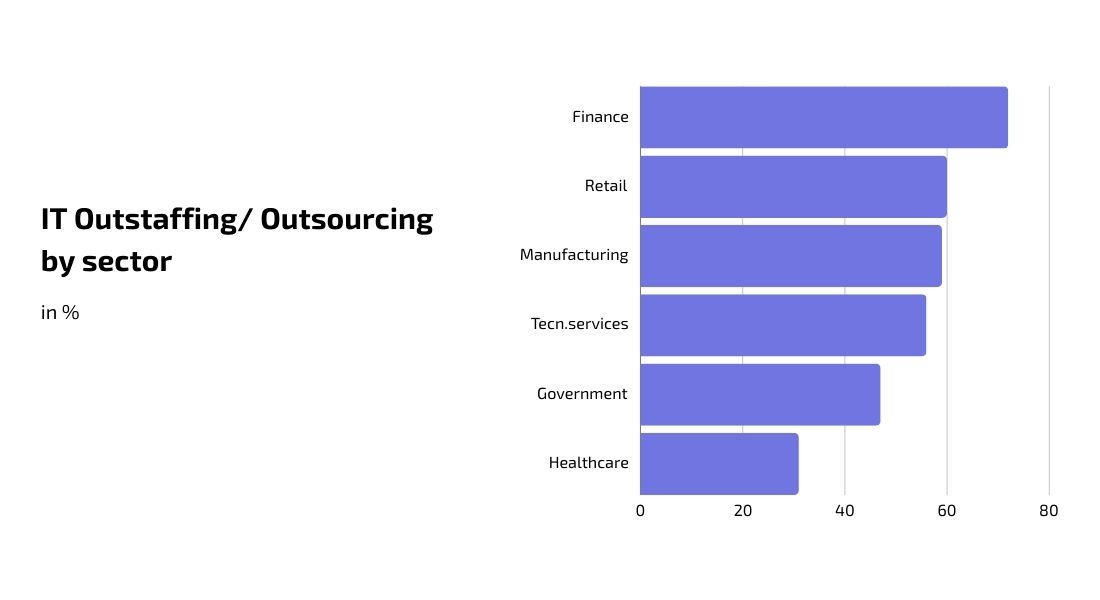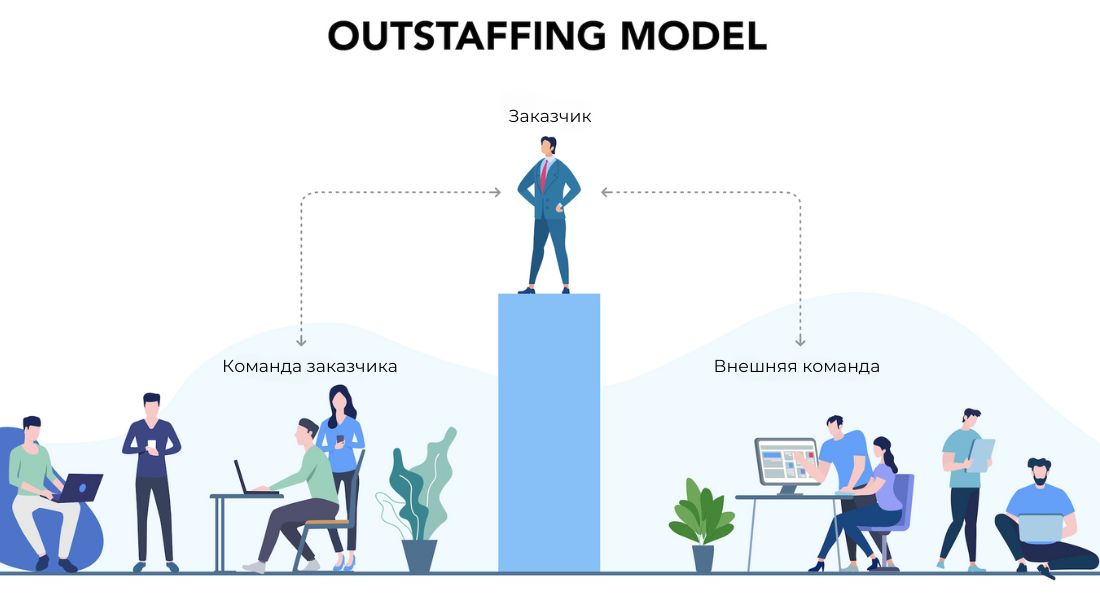Outstaffing has become popular since it gives companies huge opportunities like access to a pool of diverse talent or to fill skill gaps in the existing team. In addition, outstaffing expands the technical capabilities of the project with the help of third-party expertise and guarantees project timely release. With the help of IT outstaffing, the customer can optimize risk management: the outstaffer assumes all responsibility associated with hiring an inappropriate developer or his dismissal.
Statista predicts that IT outstaffing and outsourcing revenue will reach US$541.10 billion in 2024, highlighting the attractiveness of the software development outstaffing model.
What is IT Outstaffing?
Outstaffing of IT specialists means the attraction of external developers through a specialized company that takes on administrative responsibilities for employment. The client company receives all the necessary resources for its projects, managing specialists as its temporary employees, without worrying about the processes of hiring, registration and other HR tasks. This allows customers to focus on key aspects of the work and quickly scale their team if necessary.
Outstaffing teams are an integral tool for ensuring sustainable development of a growing company.
In what spheres outstaffing is in demand now?

Let’s say a startup that develops a mobile fitness app receives investment and decides to accelerate the launch of the product to the market. Instead of a lengthy hiring process, the guys decide to use outstaffing to immediately attract experienced developers and UI/UX designers. This allowed them to quickly expand their own development team and focus on creating and testing the product, significantly reducing time to market.
A few more examples:
A telecommunications company needs to improve the resiliency and performance of its systems to serve a large number of users. The company turns to outstaffing to hire DevOps engineers who use automated tools to monitor and manage network infrastructure.
Involving DevOps engineers helps stabilize the project situation and close productivity gaps. First, DevOps engineers have expertise in using technologies such as Kubernetes and Docker, which can significantly speed up the deployment and scaling of applications. This is especially important for a telecommunications company serving millions of users, where any delay or downtime can lead to colossal losses.
Secondly, with the help of automation tools (Ansible, Puppet or Chef) DevOps specialists can effectively manage the configuration of servers and network devices, ensuring their uninterrupted operation and prompt updating. This reduces the risk of human error and improves overall system reliability.
In addition, DevOps engineers use modern monitoring and logging systems (most often Prometheus and Grafana), which allow them to identify and fix problems in real time, as well as analyze network performance. This helps to quickly respond to incidents and prevent potential failures on projects.
To ensure the required level of DevOps data security, engineers integrate DevSecOps practices by implementing automated security testing and vulnerability management tools such as Aqua Security and SonarQube.
How outstaffing works?
Let’s talk about how outstaffing works in practice. The outstaffing cooperation model consists of the following stages:
- The company turns to an outstaffer;
- An introduction call is conducted in order to understand the customer’s request, business characteristics and technical requirements for a specialist;
- The outstaffer selects a specialist or team for the customer’s tasks;
- The customer selects suitable specialists and interviews them;
- The outstaffing agency and the customer discuss rates for specialists, most suitable cooperation model and reporting options;
- The outstaffing company conducts onboarding of specialists on organizational issues (the process of agreeing on overtime, hours worked, vacations);
- Specialists begin to work in the customer’s team;
- Managers of the outsourcing company monitor the progress of the project, resolve current issues, monitor the fulfillment of contractual obligations and tasks;
- At the end of cooperation, the customer can transfer the specialist to another project or continue cooperation.
Models of outstaffing IT specialists
- Project outstaffing
A situation where the customer wants to transfer the development of the project to an external team, provided that the requirements for the project and the expected scope of work are already known. After communication between the customer and the outstaffing company, the project is estimated (the agency evaluates the scope of work and requirements for the project and determines the cost). - Dedicated Team Model
For example, turnkey application development is a variant of the dedicated team model. This model involves dedicating an entire development team to a specific task or product. - T&M Agreement
A Time & Material contract is ideal for a project without a clear and precise understanding of time and cost. In this case, the model is based on actual performance results.

When does a business need IT outstaffing?
- The company lacks an employee with a rare technology stack;
- The company cannot fill the need for a certain specialist for a long time;
- It is not possible to keep employees on staff;
- When a company needs a ready-made team of specialists to complete an extensive task;
- The need for a quick start (due to the fact that the time spent on registering employees is reduced);
- It is necessary to relieve the workload of the company’s key employees;
- If there is a request for a temporary project or employees are needed for a set period.
Advantages of outstaffing as a cooperation model
- Cost optimization
IT outstaffing allows companies to hire qualified professionals at a lower cost than hiring full-time employees. Tax and social payments for IT specialists are made by their main employer, which reduces costs and reduces the burden on the HR department.
For the customer, hiring employees using the outstaffing model is completely safe – specialists are officially registered under a contract (no freelancers and no risks to the company’s reputation). - Reduced organizational burden
When collaborating on an outstaffing model, the client does not incur financial and time costs when hiring and firing employees. - Team Expansion
Companies can easily scale their teams to meet business needs, without the constraints of long-term contracts. - Advanced Expertise
IT outstaffing provides access to a global base of highly qualified professionals with expertise in various technologies and industries. - Time saving
With the help of IT outstaffing, companies can quickly assemble teams of professionals who will help speed up product development and get to market faster. - Focus on core competencies
Outsourcing non-corporate functions to IT outstaffing companies allows businesses to focus on their core competencies and strategic initiatives, leading to better results and higher productivity. - Access to international experience
Often, developers working on the outstaffing model have experience working on projects from different countries, which expands their capabilities and competencies, offering more innovative solutions for the implementation of your projects. - Flexibility
Outstaffing makes it possible to hire employees without being tied to a specific region.
What is important to consider when choosing an IT outstaffing company?
- Pay special attention to the specialist’s experience
When choosing an outstaffing company, take into account the main directions and expertise of the company, the practice of solving specific problems and the industry competence of the specialists offered to you. Find out if the team has employees with competencies in the required technologies and products. - Study company cases and pay attention to reputation
Reliable providers will have a set of cases on their website with a detailed description of the implemented solutions. Review cases that are similar to your request to understand whether the company has the necessary expertise. - Find out how the company will protect your data
Your data must be reliably protected during cooperation. Please clarify what data protection methods will be used. For example, does the company use data encryption, VPN, role-based access control, IDS/IPS. - Discuss the terms of communication
For successful cooperation, already at the initial stages it is necessary to agree on the rules of communication and select suitable methods for communication. It is important to choose a contractor who can provide timely feedback so that changes to the project are implemented as quickly as possible. - Ask about conflict management
When choosing an outstaffing company for IT services, it is important to pay attention to its experience and competencies in the field of conflict management, the presence of clear procedures for resolving disputes, and feedback from other clients about the company’s ability to cope with conflict situations. This will ensure smooth and productive, and most importantly, long-term cooperation.
FAQ
How is privacy regulated?
To ensure secure cooperation and all important data, a non-disclosure agreement (NDA) is signed.
What are the conditions and processes for changing the scope of work or replacing specialists?
If the scope of work is changed by the customer, the latter must inform the outstaffing company about his decision for further coordination of the work.
Replacing a specialist can happen either at the request of the customer or at the request of the specialist himself. As a rule, replacing specialists on a project is associated with unsatisfactory work results or inconsistency of the technology stack. In such cases, the outstaffing company as soon as possible (or within the period specified in the concluded contract) selects a relevant replacement taking into account the customer’s requirements. If the initiative to remove a specialist comes from an outstaffing company, then the latter must notify the customer no more than 2 weeks in advance.
How can you control the productivity and quality of work of an outstaff team?
Project management and task management are carried out through the JIRA and Confluence systems, allowing the client to always be aware of the progress of the project.
How quickly can work on a project begin?
ASAP. A specialist can start at any time. The main thing is that all necessary documents are signed.